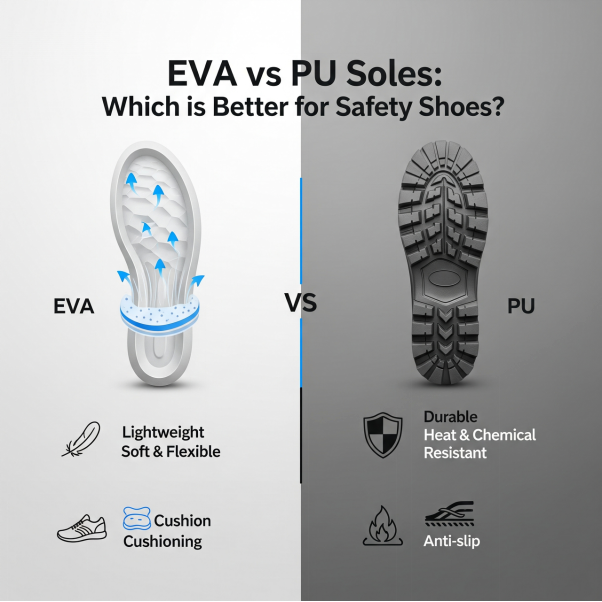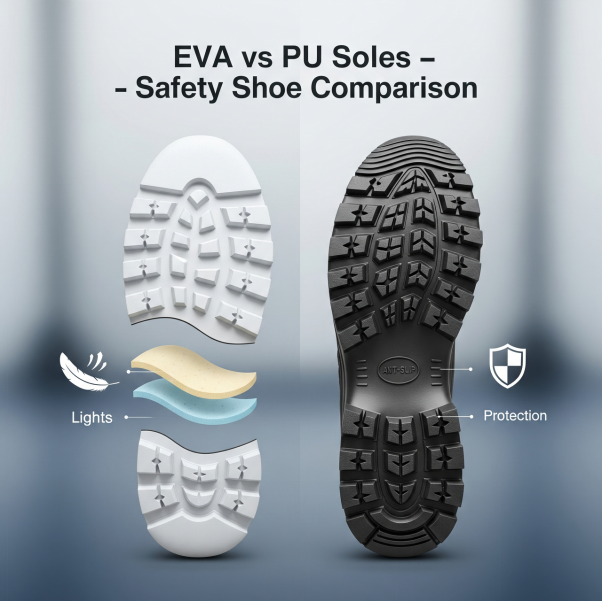Let's not debate but get your final verdict on what's better material in Best Safety Shoes—EVA or PU soles. When it comes to protective footwear, comfort and protection go hand in hand, alongside safety features. Workers across various industries, including construction, manufacturing, logistics, and steel plants, rely on safety gear, such as safety shoes.
The features such as composite toes, ankle coverage, and slip-resistant are essential, but what about the type of sole under the feet? It does make a difference, or it doesn't—let's find out. Typically, the most widely used soles are EVA (Ethylene Vinyl Acetate) and PU (Polyurethane).
Both materials have carved a niche in the market, but their properties, durability, and comfort vary significantly. For those seeking the best lightweight safety shoes in India , understanding the difference between EVA and PU soles is crucial.
best lightweight safety shoes in India
You can deny the sole quality in safety shoes—it's more than a base, as defined.
- Shock absorption during long hours of standing or walking
- Slip resistance in industrial or outdoor environments
- Protection from sharp objects, chemicals, or electrical hazards
- Overall comfort that directly affects worker productivity
From your need for Electrical Safety Shoes to High Ankle Safety Shoes , protective footwear influences performance, durability, and comfort.

EVA Soles: The Lightweight Contender
EVA, or Ethylene Vinyl Acetate, is a foam-like material that's widely known for being extremely light and cushioned. The sole material is commonly found in running shoes, sandals, and even in industrial safety shoes, offering great comfort.
Key Benefits of EVA Soles:
- Lightweight Feel – EVA soles are lightweight, thus widely used in footwear. This feature makes it a popular choice for professionals who are constantly on their feet for prolonged hou
- Cushioning & Comfort – The foam-like structure of EVA ensures excellent shock absorption, reduces fatigue, and enhances comfort for extended periods.
- Flexibility – EVA soles in safety shoes ensure ease as they bend easily, allowing better mobility and natural foot movement.
- Affordability – EVA soles are generally less expensive to produce, making the overall shoe cost-effective.
Typically, high ankle safety footwear gives a rugged and authoritative appeal, especially in the brown shade.
Limitations of EVA Soles:
- Durability Concerns – The safety footwear with EVA tends to compress over time and lose its cushioning effect. The workers at heavy-duty jobs may feel discomfort at certain times—it's a drawback.
- Lower Resistance to Heat & Chemicals – EVA in safety shoes is not suitable for all work environments, particularly those involving exposure to oils and chemicals.
- Less Grip on Slippery Surfaces – Compared to PU safety shoes soles, EVA may lack the level of traction and slip resistance features.
In short, EVA soles are best suited for light industrial work. warehouses, or jobs that require mobility but not prolonged exposure to harsh conditions.
PU Soles: The Durable Workhorse
Polyurethane, or PU, has become a highly preferred safety shoe sole as it shares a balance of comfort, durability, and protection. PU soles are denser than EVA, yet they remain relatively lightweight compared to traditional rubber soles.
Key Benefits of PU Soles:
- High Durability – PU soles that resist wear and tear, making it ideal for long-term use in industries.
- Heat & Chemical Resistance – PU performs better under exposure to heat, oils, and mild chemicals, making it suitable for workshops, factories, and outdoor sites.
- Excellent Slip Resistance – PU soles ensure better grip, reducing the risk of workplace accidents.
- Shock Absorption – Though not as soft as EVA, PU provides adequate cushioning while maintaining structure over time.
- Versatility – The single density and dual density design; PU soles offering comfort on the inside; rugged durability from the outside.
Limitations of PU Soles:
- Slightly Heavier than EVA – Comparing PV and EVA, it's heavier, which isn't preferable when prioritizing ultra-light shoes.
- Higher Cost – PU soles do tend to be more expensive than EVA—longer lifespan justifies the price.
- Less Flexible – The sturdier PU soles make it flexible than EVA, impacting mobility for some workers.
For high ankle safety shoes and electrical safety shoes, PU soles are often the preferred choice because of their resilience and protective properties.
EVA vs PU: Which One Should You Choose?
When deciding between EVA and PU soles, the choice depends on work roles, job demands, and comfort preferences.
Choose EVA soles if:
- You need the lightest safety footwear possible.
- You work in warehouses, logistics, or jobs that involve a lot of walking but low exposure to hazards.
- Comfort and cushioning are your top priorities.
Choose PU soles if:
- You need footwear for heavy-duty industrial environments.
- You need footwear for heavy-duty industrial environments.
- You require high ankle safety shoes or electrical safety shoes with extra protection.
The briefing is that EVA prioritizes comfort-first, while PU serves as a layer of protection. However, both have significant roles in safety shoes, which helps maintain job demand.
The Importance of Lightweight Safety Shoes in India
India demands development, and thus, skilled labour needs safety as a priority. From safety gear to the best safety shoes for various jobs, including construction, automotive, oil & gas, electrical, and warehousing, safety is paramount everywhere.
The prolonged shifts with heavier footwear are unbearable; thus, picking the Best Lightweight Safety Shoes in India for workers is crucial to increase productivity. By combining international standards and designs,Safety Shoes Suppliers in India are now following the trend by selecting the best material, incorporating both PU soles for enhanced safety and EVA midsoles for added comfort, thereby creating hybrid protective footwear.

The Final Verdict
Talking about the best materials in safety shoes, EVA and PU both serve an imperative role in the world of protective footwear. With its lightweight design, flexibility, and cushioned soles, these shoes are a wise choice for workers. Other side jobs expose workers to heat, chemicals, heavy loads, and slippery conditions; PU soles ensure the durability and safety of the shoes.
FAQs
Q1. Are EVA soles safe enough for industrial work?
EVA soles are safe for low-risk environments like warehouses or logistics, where cushioning and lightness are more critical than heat or chemical resistance. For heavy-duty industrial sites, PU soles are generally recommended.
Q2. Can electrical safety shoes have EVA soles?
Most electrical safety shoes use PU or rubber soles because these materials offer better resistance to heat and electrical hazards. EVA soles are rarely used in this category due to their lower protective performance.
Q3. Which lasts longer, EVA or PU soles?
PU soles typically last much longer than EVA soles. While EVA soles may lose cushioning over time, PU soles maintain structure and grip, making them more durable for long-term use in harsh environments.
